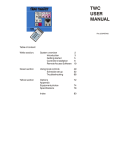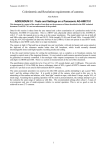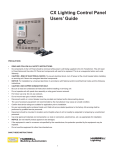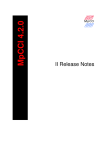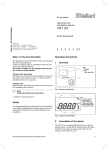Download RKD Application Guide
Transcript
TUCOR RKD CONTROL SYSTEM In 1995, TUCOR was the first company to bring proven “two-wire” control technology from Europe to the American landscape irrigation industry. For over ten years now, Tucor has been developing and introducing new products to satisfy a broad variety of high-end irrigation control requirements. Now, with the new Tucor RKD Controller, two-wire control has been simplified. It is now much easier for contractors who have not made the transition from conventional control systems to two-wire systems. There is now an opportunity to take advantage of the many benefits of this technology. WHAT IS “TWO-WIRE” CONTROL? “Two-wire” irrigation control is a low-voltage irrigation control system that utilizes a two-conductor wire to power all of the valves in an irrigation system. All valves are connected to the same pair of wires, so the need for multiple control wires is eliminated. There are four major components of a “two-wire” control system: #1 THE CONTROLLER The controller (in this case, the RKD) provides the power and programming to operate the valves. It requires 120 volts AC, like most other controllers. RKD CONTROLLER (Door Closed View) (Door Open View) (Internal View) Internal Transformer 120-Volt Power Wire 1 #2 THE “TWO-WIRE PATH” The “two-wire path” carries the power from the controller to the valves. This “two-wire path” is simply a two-conductor wire (Tucor #16/2) that all valves are connected to. Valves can be connected to the two-wire path in series like a string of ornamental lights. There is no polarity between the conductors in a two-wire system. Tucor Wire 120-Volt Power Wire Note: “Tucor Wire” is a double-insulated, two-conductor wire made by Paige Electric specifically for Tucor. Inside a high-density polyethylene jacket are red and black insulated conductors. These conductors are color-coded for ease of troubleshooting. #3 DECODERS A “decoder” is installed at each valve solenoid and connected to the two-wire path. The decoder acts as a switching device that turns a valve on/off with a signal from the controller. Blue wires to two-wire path White wires to valve solenoid Note: Solenoid wire 150 feet max. with #18 wire. RKLD-050 DECODER RKD Application Guide 2 Decoders are usually installed at the valve they control, in the same valve box. If necessary, the decoder can be installed up to 150 feet away from the valve using #18/2 wire. RKD Controller Note: Waterproof wire connectors are required! Tucor Wire 120-Volt Power Wire RKLD-050 Decoder Control Valve (24 volt AC) Note: #4 The RKD Control System requires the RKLD-050 decoder. Tucor “Flowmaster" decoders are not compatible with the RKD system. SURGE PROTECTORS All electrically controlled irrigation systems should have proper grounding installed to protect against potentially damaging electrical surges. Tucor two-wire control systems utilize SP-100 surge protectors to provide this protection. SP-100 surge protectors are installed at regular intervals along the two-wire path and connected to a ground rod at each ground point. RKD Application Guide 3 WHY USE THE RKD “TWO-WIRE” SYSTEM? #1 LESS WIRE IS NEEDED The RKD can operate up to one hundred valves from a #16/2 wire. The decoders along the two-wire path eliminate the need for multiple wires and multiple station terminals at the controller. Using RKLD-050 decoders, valves are connected in series along the two-wire path like a string of ornamental lights. Note: This system does not require special valves and will work with most 24-volt AC solenoid valves on the market. Tucor wire to next valve #2 VALVES ARE EASILY ADDED Existing valve & decoder Existing valve & decoder Existing two-wire path Valves can be easily added to a two-wire system without running new wires back to the controller. Anywhere a valve is needed, it is simple to splice into the two-wire path, install a decoder and wire the new valve to it. RKD Application Guide 4 #3 EXTENDING THE SYSTEM IS SIMPLIFIED The two-wire path can be easily extended into new areas of the landscape. By connecting anywhere into the two-wire path and extending the wire, the system can be expanded. Again, there is no need to run wires back to the controller. Existing two-wire path Two-wire path extended to new area New wire spliced into existing wire path. Note: Wire splices should always be made in valve boxes. #4 THE CONTROLLER CAN BE EASILY RELOCATED The controller can be relocated anywhere along the two-wire path. The location of the RKD does not have to be permanent. RKD Application Guide 5 The previous illustrations have shown valves connected to the RKD via a single two-wire path. The RKD actually has two sets of terminals, labeled #1 A-B and #2 A-B. These two sets of terminals allow the use of two separate two-wire paths from the controller. #1 Wire Path Terminals Green Tucor Wire #2 Wire Path Terminals Blue Tucor Wire In larger installations, where possible, it is a good practice to locate the controller near the control midpoint of the entire system and use both sets of terminals. In this way, approximately one-half of the valves would be connected to wire path #1, while the other half is connected to wire path #2. It is also recommended that a different color of Tucor wire be used for each wire path. These practices make wire tracking and troubleshooting much simpler. The following illustration shows the controller located at the center of the system with the valves divided between the two wire paths. RKD Application Guide 6 #5 VALVES CAN BE OPERATED AT GREAT DISTANCES WITH SMALL GAUGE WIRE With the RKD, multiple valves can be operated at much greater distances, with smaller wire, than conventional systems. The RKD can operate valves over one mile away with #16/2 wire! Also, multiple valves can be operated simultaneously with much smaller wire than conventional systems allow. The RKD can simultaneously operate twelve valves, one master valve and two pump starts using one #16/2 wire. RKD MAXIMUM WIRE LENGTHS RKD Max. wire length with 1 active valve per wire path = 6,200 ft.* RKD Max. wire length with 2 active valves per wire path = 5,600 ft.* RKD Max. wire length with 3 active valves per wire path = 4,900 ft.* RKD Max. wire length with 4 active valves per wire path = 4,300 ft.* * Wire lengths shown are based on #16/2 Tucor wire, with all the decoders at the end of the wire (“worse case”). For other, more typical arrangements, see the chart below. RKD Application Guide 7 Number of simultaneous valves 1 2 3 4 5 6 7 8 9 10 10 + 1 manual 10 + 2 manual Valves evenly distributed along 2-wire (ft.) Worse case: all valves at end of 2-wire (ft.) AWG 18 AWG 16 AWG 14 AWG 18 7,000 6,400 5,500 4,900 4,400 4,000 3,600 3,300 3,100 2,800 2,700 2,500 11,000 10,200 8,800 7,800 7,000 6,300 5,800 5,300 4,900 4,600 4,300 4,000 17,800 16,300 14,100 12,500 11,200 10,100 9,200 8,500 7,800 7,300 6,800 6,400 3,900 3,500 3,100 2,700 2,400 2,200 2,000 1,800 1,700 1,600 1,500 1,400 AWG 16 6,200 5,600 4,900 4,300 3,900 3,500 3,200 2,900 2,700 2,500 2,300 2,200 AWG 14 9,900 9,000 7,800 6,900 6,200 5,600 5,100 4,700 4,300 4,000 3,800 3,500 Note: distances given using default valve power settings; if a higher power setting is used, distances are shorter. Chart of the maximum distances in feet of the two-wire path (that is, from the RKD controller to a valve), for a given wire gauge and the number of simultaneously active valves. RKD Application Guide 8 #6 REDUCED UTILITY COSTS With the RKD, many valves can be operated over greater distances with small gauge wire. In many situations, multiple controllers and power sources can be minimized, reducing the cost of electrical contractors, utility connections, and ongoing electric company billings. The following example illustrates this point: In this example, control valves are spread around a large site. Because of the distances between valves and the need for large gauge wire, multiple controllers are being considered. CONVENTIONAL CONTROL SYSTEM AREA #1 AREA #2 New Electric Service AREA #3 New Electric Service New Electric Service Electric Meter Controller With the RKD controller, valves can be operated over great distances with #16/2 wire. Therefore, one controller can be used, saving on electric service costs. RKD CONTROL SYSTEM AREA #1 The need for a new electric service is eliminated! Two-wire path replaces multiple control wires AREA #2 New Electric Service AREA #3 The need for a new electric service is eliminated! Two-wire path replaces multiple control wires The RKD offers great advantages in this situation: ü All valves can be operated from one controller (up to 6,700 feet away) ü Only one electrical hookup is needed ü Electrical contractor installation costs are reduced ü Utility company installation and monthly operating costs are reduced. RKD Application Guide 9 APPLICATIONS FOR THE RKD CONTROL SYSTEM Now that we’ve reviewed the principles and advantages of two-wire control, let’s look at some practical applications for the RKD. #1 COMMERCIAL SITES In this example, a typical commercial site is shown with an office building. The irrigation system is to cover foundation plantings, landscaped parking lot islands and roadside buffer areas. CONVENTIONAL CONTROL SYSTEM #14/1 Control Wire #12/1 Common Wire Conventional wiring in this scenario presents many challenges: • Large conduits are required to accommodate the mass of control wires • Large wire bundles are difficult to pull through conduits • Multiple wires are difficult to track and troubleshoot • Wire sizes may need increased because of distance to valves • Extra wires must be installed to accommodate future expansion • Wire bundles are subject to damage by landscaping work RKD Application Guide 10 TWO-WIRE CONTROL #16/2 Tucor Wire With the Tucor two-wire system, design, installation and service problems are solved: • Less wire – about ¼ vs. conventional wiring • Use smaller conduit since there is less wire • Easier installation with only one cable required • Less wire means less exposure to potential damage • Only two wires to track and repair • Expanding the system is simple RKD Application Guide 11 #2 PHASED PROJECTS In this example, a multiple building site, such as an apartment complex is shown. The buildings are constructed in phases as numbered, which presents challenges in design, installation and service. CONVENTIONAL CONTROL SYSTEM #14/1 Control Wire #12/1 Common Wire As a result of phased-in construction, each building has its own irrigation controller, which creates a set of problems: • • • Each controller requires its own power source. Multiple controllers in limited-access areas increases service time. Controller locations are fixed and not easily changed. RKD Application Guide 12 • • • • The number of controllers increases service time, even for minor changes. No coordination between controllers makes it difficult to program within water windows and conform to local water regulations. The quantity of buried wire increases the possibilities for damage by landscaping activities. As more buildings are constructed in future phases, all control problems are multiplied. TWO-WIRE CONTROL #16/2 Tucor Wire With the Tucor two-wire system, design, installation and service problems are solved: • Requires only one controller • Just one power source required • Controller access and service time is reduced • Programming is simplified • Water window requirements can be met (with sufficient hydraulic capacity) RKD Application Guide 13 • • • • • • #3 Extending the control system is simple – splice into the two-wire path anywhere and add valves or extend wire as needed Adding new buildings to the system is easy Controller location is not permanent – can be moved anywhere along the two-wire path Uses much less wire –about 1/3 as compared to a conventional system Less buried wire reduces exposure to damage Troubleshooting two wires is much simpler than conventional wiring SPORTS FIELD COMPLEX – CONTROL RETROFIT In this example, several athletic fields have been built over time, each with a separate controller. Programming has been complicated by insufficient hydraulic capacity. Scheduling was not coordinated and hydraulic capacity was exceeded resulting in poor coverage, poor field conditions and excessive water use. The solution is to retrofit the existing controls with a new two-wire control system that requires only one controller. CONVENTIONAL CONTROL SYSTEM #14/1 Control Wire #12/1 Common Wire RKD Application Guide 14 Separate controllers for each field present problems: • Individual controllers make coordination of programs difficult • Bad irrigation practices since hydraulic capacity isn’t managed • Poor irrigation = poor field conditions • Water use is excessive because of lack of controller coordination (watering time, rain shut-off, etc.) TWO-WIRE CONTROL #16/2 Tucor Wire With the Tucor two-wire system, irrigation practices are improved and operating costs are reduced: • • • • • Single controller allows easier programming Scheduling of water use is now managed Operating costs reduced: less labor, less water Easy to extend the system to new fields in the same complex without adding controllers Uses 1/5 wire of the conventional system RKD Application Guide 15 #4 ROADWAY PROJECT In this example, a highway beautification project requires irrigation for landscaped medians and roadside buffer areas. CONVENTIONAL CONTROL SYSTEM #14/1 Control Wire #12/1 Common Wire Long, linear projects such as this present unique challenges: • Heavy gauge wire (#14, #12, #10 and larger) is needed to overcome voltage loss over great distances from the controller • Large conduits are needed for massive wire bundles • Large wire bundles are difficult to pull through conduits • Multiple wires are difficult to track and troubleshoot and are subject to damage by landscaping work • Extra wires must be installed to accommodate future expansion TWO-WIRE CONTROL SYSTEM #16/2 Tucor Wire RKD Application Guide 16 With the two-wire system, design, installation and service problems are solved: • • • • • Less wire needed – requires approximately ¼ the total wire vs. conventional control systems Smaller wire is required – valves can be operated over greater distances with small gauge wire, like #16/2 Reduced cost of road crossings since smaller conduit can be used Only one cable needed o easier installation o easier tracking & troubleshooting o less exposure to damage Easy to extend the system for future phases – simply splice into two-wire path anywhere and extend RKD APPLICATIONS: ü Sports field complexes ü School districts ü Municipalities ü Homeowners associations ü Real estate developers ü Nurseries, tree farms, orchards ü Small agricultural RKD Application Guide 17 INSTALLING THE RKD CONTROL SYSTEM STEP #1 SELECTING THE CONTROLLER LOCATION 15 ft. minimum Electric Motors: • Pumps • AC Units • Compressors • Refrigerators • Etc. When selecting a location for the RKD controller, choose a mounting point at least 15 feet from away from high current drawing electric motors such as pumps, AC units, compressors, etc. to avoid electromagnetic interference. STEP #2 CONNECT THE POWER SUPPLY The RKD has an internal transformer that requires a 120-volt AC power supply. For ease of service, it is best if the controller is connected to a dedicated electrical circuit. All electrical work should be done in accordance with local codes. RKD Application Guide 18 STEP #3 CONNECTING THE TWO-WIRE PATH There are two sets of terminals for the twowire path: #1 and #2. It is recommended that both wire paths be used, dividing the valves between them. This makes future trouble-shooting easier. The wire paths can also be split at the controller to further divide the system. All splices should be made in weatherproof junction boxes as shown. IF THE WIRE PATHS MUST BE SPLIT BELOW THE GROUND, ALL WIRE SPLICES MUST BE MADE WITH TUCOR WATERPROOF SPLICE KITS IN EASILY ACCESSIBLE VALVE BOXES! Note: Tucor wire has red and black insulation on the two conductors for easier identification. The two-wire path is not polarized. RKD Application Guide 19 STEP #4 PROGRAM THE DECODERS Program the decoders to the desired station number. Don’t forget to label the decoders as you program or re-program them. Decoder programming can be done at the controller or in the field using the HCP-100. Important: Decoders can be reprogrammed to new station numbers. There is no limit on the number of times a decoder can be reprogrammed. RKD Application Guide 20 #5 INSTALL THE DECODERS The following illustrations show typical wiring scenarios. Refer to the “RKD Application Drawings” in the appendix for more details. RKD WITH MASTER VALVE RKD WITH BOOSTER PUMP RKD Application Guide 21 Note: The decoder can supply about 100 ma of continuous current to a motor relay. If the pump start relay requires more than this, an intermediate low-power (“ice cube”) relay will be required. Note: All wire connections must be made in valve boxes with waterproof splice kits! Installation Tips: • • • • • • • • • • DO NOT ATTACH MORE THAN ONE VALVE TO A DECODER! Use caution when stripping insulation from the Tucor wire. Nicks in wire and insulation can lead to problems. Lightly score the outer jacket, bend and pull off exposing the two inner conductors. Strip insulation from the black and red conductors. Be careful not to score the copper wire when stripping insulation. Use the waterproof wire splices that are shipped with the decoders. Make all splices in valve boxes Mark the location of all decoders, splices and surge protectors on the plans. Leave 12" of wire coiled at all splices for easier servicing. Keep splices upright and high in the valve box to avoid submersion. RKD Application Guide 22 #6 GROUND THE SYSTEM For protection from electrical surges, the RKD control system requires proper earth grounding using SP-100 surge protectors and ground rods. Install grounds every 600 feet along the twowire path and at every “dead end” that is 25 feet or longer. SP-100 Surge Protector with ground rod Ground points should be tested for earth-to-ground resistance of 50 Ohms or less. Additional grounding may be required to decrease resistance to 50 Ohms or less. SP-100 surge protectors are shown in separate valve boxes for clarity. They may be installed in the same valve box as the nearest decoder. Note: All wire connections must be made in valve boxes with waterproof splice kits! #7 TESTING THE SYSTEM The RKD has built-in diagnostic test features that will aid you in monitoring and checking the electrical condition of the system. Having a basic understanding of the electrical characteristics of the RKD system will greatly enhance your troubleshooting skills and cut down on service time. BASIC ELECTRICAL FACTS: • The controller continuously puts out approximately 36 volts AC, so the two-wire path is always energized unless the control dial is in the “IRR. OFF” position. • Current in the two-wire system is measured in “milliamps” (ma). • With no decoders and valves connected, the controller puts out approximately 36 volts at 2 milliamps. RKD Application Guide 23 • • • • • When connected to the two-wire path, each decoder draws approximately 0.5 milliamps in “standby” mode, i.e., no valves open. As decoders are connected to the system, the standby current draw increases by approximately 0.5 milliamps per decoder. Theoretically, an RKD controller with sixty decoders attached should draw approximately 32 milliamps. (60 decoders x 0.5mA + 2ma for the controller) Full load output from the controller is approximately 600-700ma. When a single valve solenoid is energized, the current draw is approximately 40 - 50 milliamps (depending on the solenoid’s characteristics). Multiple valves operating simultaneously will draw more current as follows: 1 valve = 40 - 50 ma 2 valves = 80 - 100 ma 3 valves = 120 - 150 ma 4 valves = 160 - 200 ma ... 10 valves = 400 – 500 ma Note: Master valve and pump start current not included. CHECKING LINE CONDITION LineV/MA values referred to in this section are enabled under “Advanced Setup” options; see your User’s Manual. When enabled, the time-of-day is not displayed on the screen. Steady, alternating red and green LED’s indicates normal line condition. With no active valves, the line display should read approximately 36 volts / x ma (ma will depend on the “x” number of decoders connected to the system; see “Basic Electrical Facts” above). Hesitating red and green flashing LED’s indicate a problem in the two-wire path. Check the #1 wire path by disconnecting the #2 line, and vice-versa, to isolate the faulty wire. (But also note that the LED’s will quickly flash for a few seconds from time to time, as, for instance, when valves are turned on or off. This is normal communications on the two-wire.) If the LED’s are not lit, with power on, this indicates a dead short in the two-wire path. In this state, the line display will read less than 22V and 150 - 200mA. If so, check for crossed wires or physical damage to the two-wire path. Disconnecting the two-wire path at the controller should cause the LED’s to flash as normal. This confirms a two-wire path problem. Line condition is also tested when performing a “Station Test”. RKD Application Guide 24 PERFORMING A STATION TEST Once installation is complete, a simple station test should be run. This will check decoder and valve electrical operation. USER: SET DIAL POSITION TO: “SETUP/TEST” DISPLAY SHOWS: USER: ** Setup and Test Functions ** Choose action from buttons below. PUSH BUTTON: “WATER BUDGET / STATION TEST” (Red light next to button will flash) DISPLAY SHOWS: Start from: ** Station Test ** ST1 Line: 36v/ X m [X varies, depending upon total decoders connected.] USER: PUSH “ENTER / YES” BUTTON TO TEST “ST1” (Station #1) or SELECT ANOTHER STATION TO TEST WITH THE UP/DOWN ARROWS…THEN PUSH “ENTER / YES” DISPLAY SHOWS: ** Testing Station ST1 ** Please Wait! If the test was successful: DISPLAY SHOWS: ** Test of Station ST1 Station: 656ma/ 53ma ***OK*** Line: 36v/ Xm Station readings indicate normal current situation. The “656” = Inrush current to solenoid The “53” = Holding current to solenoid Your values may differ, depending on the solenoid. If the test failed: DISPLAY SHOWS: ** Test of Station ST1 Station: 664ma/ 9ma !!! FAILED !!! Line: 36v/ Xma Station readings indicate a short at solenoid. OR ** Test of Station ST1 Station: 12ma/ 12ma RKD Application Guide !!! FAILED !!! Line: 36v/ Xma 25 Station readings indicate an open (i.e., broken wire) at solenoid. PROGRAMMING Once the decoders have been programmed and installed and each station tested, the controller can be programmed. The procedure for programming the RKD is very similar to other irrigation controllers: 1. Set DATE & TIME 2. Select a PROGRAM (1 – 4) 3. Select a STATION (1 – 100) 4. Enter a RUN TIME (0 – 999 min.) Repeat Step #4 for each station 5. Select program WATER DAYS (S-M-T-W, etc.) 6. Enter program START TIMES (1 – 6) 7. Set program WATER BUDGET (0 – 250%) 8. Set program as ACTIVE OR PASSIVE 9. Repeat steps for the next program. The capabilities of the RKD controller are as follows: Station Capacity: 100 valves Max. Active Valves: 4 + 1 Master Valve Master Valves: 1 Pump Starts: 2 Programs: 4 + 1 test program Concurrent Programs: 4 Start Times: 6 per program Calendar: 14 days Station Run Times: 0 – 999 min. in 1 min. increments Water Budget: 0 – 250% in 1 min. increments Program Modes: Active & Passive Start Methods: Auto, Manual by program or station Display: Monitors active programs, run times and line condition Decoders: Programmable and testable at the controller Diagnostics: Decoder pass/fail, short test Terminals: Rain sensor, alarm, ET Serial Port: PC connection for firmware updates RKD Application Guide 26 For advanced features, see the RKD User Manual. HOW IS THE RKD DIFFERENT FROM OTHER TUCOR CONTROLLERS? The RKD was developed to simplify two-wire technology and to make it economically feasible for smaller scale projects of up to 100 valves. Many of the advanced features found in Tucor’s Flowmaster Series of controllers (TWC, Com, ProCom, etc.) were eliminated or scaled down in design of the RKD. The following comparison chart illustrates some of the differences between the RKD and the TWC controller. This chart should help you in deciding if the RKD is the right choice for your project, or perhaps you will need the greater capabilities of the TWC controller. Valve Capacity Simultaneous Valves Master valve/pump start Booster pumps User Interface Upgradeable capacity Max. Programs (Schedules) Programming Method Valve sequence Rain Sensor Input ET capable Flow sensors Alarm & React to Flow Remote Software On-Line Monitoring Data Logging & Reports Communication Options Decoder Decoder Test Short Circuit Test Upgradeable Firmware RKD TWC 100 50/100/200 4 10 1 1 2 9 Dial & button Dial & button or remote software No Yes 4 + 1 test 10 + 1 test Programs & Stations Schedules & Steps Fixed sequence 1 thru 100 Sequence is programmable Yes Yes Yes Yes N/A 10 N/A Yes N/A Yes N/A Yes N/A Yes N/A Yes Programmable Non-programmable Yes Yes Yes Yes Yes Yes The other major difference between the RKD and TWC control systems is in the decoders that are used. The RKD controller requires the RKLD-050 decoder that is different from those used with Tucor Flowmaster controllers. The RKLD-050 decoder is designed to operate a single valve per station. It was designed to be user-programmable at the RKD controller or with the HCP-100 hand programmer. The user can easily program (or re-program) a decoder to operate a given station. Flowmaster decoders are available in single and multiple valve models. These decoders are not programmable at the controller but can be reprogrammed with the HCP-100 hand programmer. Flowmaster decoders are shipped with predetermined identification RKD Application Guide 27 numbers (addresses). These addresses must be associated with valve locations and entered into the controller database. It is the ability to create this database that gives the Flowmaster controllers powerful operating flexibility. Most notably, the user can program the sequence that valves turn on/off by schedule (program). The RKD controller uses a much simpler operating arrangement than the Flowmaster controllers and decoders. Valves turn on/off in sequence (1 through 100) just like a conventional controller. The RKD will only operate with the RKLD-050 decoder. This decoder is a single-valve, programmable decoder that is shipped in a “blank” state without any programming. Since the RKD uses the concept of “stations” instead of “addresses” (as in the Flowmaster), programming is very easy for a newcomer to two-wire control systems. This decoder can be programmed with a station number (1 through 100) right at the controller by connecting it to the designated terminals and following the on screen steps. The decoder is labeled as station #_____ and wired to the valve where you want that station number. If you want to change the station number for a valve, you can re-program the decoder to the station number that you want. An optional handheld decoder programming unit is available for programming or reprogramming decoders in the field. RKD Application Guide 28 APPENDIX A RKD Application Guide 29 RKD Application Guide 30 RKD Application Guide 31 RKD Application Guide 32 RKD Application Guide 33 RKD Application Guide 34 RKD Application Guide 35 RKD Application Guide 36 RKD Application Guide 37 APPENDIX B RKD Application Guide 38 TUCOR RKD CONTROL SYSTEM SPECIFICATIONS The Automatic Irrigation System Controls shall be the RKD Control System as manufactured by Tucor, Inc. of Wexford, Pennsylvania and hereinafter specified. The RKD Control System shall be comprised of the Tucor RKD Controller, RKLD050 Programmable Decoders, Tucor #16/2 Communication Cable, Tucor SP-100 Line Surge Protectors, Tucor HCP-100 Portable Decoder Programmer (Optional) and all other equipment required for a complete system. RKD CONTROLLER The Tucor RKD Controller shall be a standalone controller capable of operating one hundred 24VAC solenoid valves along a two-wire path. The controller shall be capable of simultaneously operating four valves, one master valve and two booster pumps from the two-wire path. The controller shall be capable of operating a single valve connected to the two-wire path up to 6,100 feet away using #16/2 Tucor communication cable. The RKD shall have a locking metal NEMA-rated cabinet with internal transformer requiring 120 VAC electrical input and 24 VAC output. Two-wire path output from the controller shall be 34 VAC. The controller shall have built-in lightning protection. The RKD shall have four independent programs plus one test program. Programs shall run concurrently with six start times per program over a fourteen-day calendar. Station run times shall be adjustable from 0-999 minutes in one-minute increments. Stations will operate in sequence from 1 – 100. The controller shall have a water budget feature that will adjust the water budget of each program independently from 0-250% in one percent increments. Programs shall have both active and passive modes. The controller shall have the capability to start programs and stations automatically or manually. Manual start of programs and/or stations shall be accomplished without the need to pause or cancel currently running programs. The RKD shall have a backlit display with brightness adjustment. The display shall be capable of showing the operating status of the system. Active programs, run times and the current time shall be displayed. The controller shall have an option to monitor and display the electrical conditions of the two-wire path including current (in milliamps) and voltage. The controller shall have built in diagnostics that will test for station individual station operation, decoder pass/fail and electrical shorts in the two-wire path. The RKD shall be capable of operating two booster pumps. Booster operation shall be assignable to individual programs. Valve output power shall be adjustable through menu options that allow for four different power levels. The controller shall have separate terminals for connection to a rain sensor, alarm and ET input. ET input shall be provided by an optional WR-7 or WR-100i weather sensor. RKD Application Guide 39 The controller shall include a special circuit for monitoring, on a continuous basis, the line voltage condition. In the event of an electrical short, the controller will automatically switch to 50Hz mode at reduced current. The controller shall also have terminals for connection of decoders for the purpose of programming, reprogramming and testing decoders. The optional HCP-100 hand programmer shall have the same decoder programming capabilities as the RKD50 controller. Install the RKD controller in accordance with local electrical codes and with a proper electrical ground. The controller should be mounted in an easily accessible location and at a height that allows convenient operation of controls. LINE DECODERS RKLD50 decoders shall provide the interface between the 24 VAC valves and the twowire communication from the RKD controller. RKLD50 decoders shall be shipped in a “blank” state with no programming information. For programming, decoders shall be connected to the RKD controller decoder terminals and programmed with the desired station address. Decoders shall be programmable as station numbers one through one hundred (“ST1” through “ST00”), master valve (“MV), booster pump #1 (“BO1”) or booster pump #2 (“BO2”). Decoders shall have the ability to be reprogrammed to other station addresses. The controller shall have a decoder test function that will give a decoder pass/fail test result. Each decoder shall be epoxy sealed and completely waterproof. Each decoder shall have “built-in” surge protection as an integral part of the basic decoder. The decoder shall have two (2) blue colored wires for connection to the two-wire path communication path and two (2) white colored wires for connection to the valve solenoid wires. Each decoder shall be labeled with the station address that was programmed into it. A programmed decoder shall be installed with the valve that corresponds to the programmed station number. In most cases, the decoder shall be installed in the same valve box as the valve it operates. For remote installation, the decoder to valve distance shall not exceed 150 feet using #14 wire. Decoder out put shall be 24 VAC. Each RKLD50 decoder shall be capable of operating one valve solenoid. THE LOCATION OF EACH DECODER SHALL BE MARKED ON THE AS-BUILT PLANS. RKD Application Guide 40 TWO-WIRE PATH All wire used for communication between the RKD controller and the RKLD50 decoders shall be double-jacketed, two (2) conductor cable specifically designed by Paige Electric for use with Tucor control systems. The cable shall be suitable for direct burial, or for installation in ducts or conduits. The conductors shall be #16 AWG tin-coated, soft drawn, annealed, solid copper conforming to ASTM 33 with 4/64” thick PVC (polyvinyl chloride) insulation, conforming to UL Standard #493 for thermoplastic insulated style UF (Underground Feeder), rated at 60 degrees C. The two insulated conductors shall be laid parallel and encased in a single outer jacket of 3/64” thick, high density, sunlight resistant polyethylene conforming to ICEA S-61-402 and NEMA WC5, having a minimum wall thickness of .045”. The outer jacket shall be pressure extruded so as to completely fill the interstices between the two insulated wires, or may have tube jacketing or form an envelope over the two insulated UF conductors lying in parallel at the discretion of the manufacturer. The two conductors shall be color coded with one conductor black and the other red. Both conductors shall be the SAME SIZE. All splices and connections in this wiring shall be made using the waterproof splice connectors provided with the RKLD50 decoder. 3M DBY wire connector kits may also be used. Any other type of wire connector will NOT be accepted. Care shall be taken with each wire connection to assure a tight, waterproof connection. IT IS ESSENTIAL THAT ALL CONNECTIONS BE ABSOLUTELY WATERTIGHT WITH NO LEAKAGE TO GROUND NOR SHORTING BETWEEN CONDUCTORS. SURGE PROTECTION All surge protection, grounding and installation of equipment specified, shall be installed in strict compliance with the manufacturer’s recommendations and in accordance with Local, State and Federal requirements. Primary Power Surge Protection: Furnish and install surge protection on the power circuit that will supply power to the controller. Field Surge Protection: SP-100 surge protectors shall be installed at every line termination point. Additional SP100’s shall be installed at every 600-foot interval along the two-wire path, located at the nearest line decoder. Connect SP-100 ground wires to a single 8-foot ground rod. If the valve is metallic or the solenoid has a metallic center pin, one of the SP-100 ground wires shall be connected to it. RKD Application Guide 41 All SP-100/ground rod assemblies shall be installed in valve boxes. Mark the location of all ground points on the as-built plans. All grounds shall be tested for earth-to-ground resistance. Readings of 50 Ohms or less are acceptable. Resistance readings of 50 Ohms or greater shall necessitate the installation of additional grounding materials to reduce the ground resistance to acceptable levels. RKD Application Guide 42














































